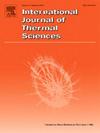Optimization of thermal noise propagation and mechanical properties at composite material interfaces
IF 5
2区 工程技术
Q1 ENGINEERING, MECHANICAL
International Journal of Thermal Sciences
Pub Date : 2025-06-30
DOI:10.1016/j.ijthermalsci.2025.110106
引用次数: 0
Abstract
This study investigated the propagation of thermal noise in composite material interfaces and the optimization of mechanical properties, focusing on applications in gravitational wave detection systems. Gravitational wave detection requires extremely high sensitivity, imposing strict demands on the propagation of thermal noise and temperature fluctuations in materials. The study analyzed the multi-interface structure of composite materials and its crucial role in temperature control and thermal noise transport, particularly examining the impact mechanisms of interfacial thermal resistance and conductivity. Through molecular dynamics simulations, the study revealed the regulatory effect of branched structures with varying numbers of monomers on heat conduction paths, demonstrating that thermal conductivity increased from 0.00384 W/(m·K) to 0.01645 W/(m·K), a 3.28-fold improvement. Additionally, the study analyzed the effect of interfacial heat source input on temperature distribution, finding that with a 0.2 W/m2 input, the temperature distribution difference was within 35 %, while with a 0.2 GW/m2 input, the difference reduced to 20 %. The study also explored the effect of monomer count in branched structures on the mechanical properties of materials, such as Young's modulus and shear modulus. The results indicated that the Young's modulus of the interface in the Z-direction increased by 152.89 % when the monomer count in the branches reached 13. The findings suggest that the rational design of interface structures can significantly optimize the thermal transport and mechanical properties of composite materials.
复合材料界面热噪声传播与力学性能优化
研究了热噪声在复合材料界面中的传播和力学性能的优化,重点研究了复合材料在引力波探测系统中的应用。引力波探测要求极高的灵敏度,对材料中热噪声的传播和温度波动提出了严格的要求。本研究分析了复合材料的多界面结构及其在温度控制和热噪声传递中的重要作用,重点研究了界面热阻和导热系数的影响机制。通过分子动力学模拟,揭示了不同单体数量支链结构对热传导路径的调控作用,表明热导率从0.00384 W/(m·K)提高到0.01645 W/(m·K),提高了3.28倍。此外,研究还分析了界面热源输入对温度分布的影响,发现当输入为0.2 W/m2时,界面热源输入对温度分布的影响在35%以内,当输入为0.2 GW/m2时,界面热源输入对温度分布的影响减小到20%。研究还探讨了分支结构中单体数量对材料力学性能的影响,如杨氏模量和剪切模量。结果表明,当分支中单体数量达到13时,界面的z方向杨氏模量增加了152.89%;研究结果表明,合理设计界面结构可以显著优化复合材料的热传递和力学性能。
本文章由计算机程序翻译,如有差异,请以英文原文为准。
求助全文
约1分钟内获得全文
求助全文
来源期刊

International Journal of Thermal Sciences
工程技术-工程:机械
CiteScore
8.10
自引率
11.10%
发文量
531
审稿时长
55 days
期刊介绍:
The International Journal of Thermal Sciences is a journal devoted to the publication of fundamental studies on the physics of transfer processes in general, with an emphasis on thermal aspects and also applied research on various processes, energy systems and the environment. Articles are published in English and French, and are subject to peer review.
The fundamental subjects considered within the scope of the journal are:
* Heat and relevant mass transfer at all scales (nano, micro and macro) and in all types of material (heterogeneous, composites, biological,...) and fluid flow
* Forced, natural or mixed convection in reactive or non-reactive media
* Single or multi–phase fluid flow with or without phase change
* Near–and far–field radiative heat transfer
* Combined modes of heat transfer in complex systems (for example, plasmas, biological, geological,...)
* Multiscale modelling
The applied research topics include:
* Heat exchangers, heat pipes, cooling processes
* Transport phenomena taking place in industrial processes (chemical, food and agricultural, metallurgical, space and aeronautical, automobile industries)
* Nano–and micro–technology for energy, space, biosystems and devices
* Heat transport analysis in advanced systems
* Impact of energy–related processes on environment, and emerging energy systems
The study of thermophysical properties of materials and fluids, thermal measurement techniques, inverse methods, and the developments of experimental methods are within the scope of the International Journal of Thermal Sciences which also covers the modelling, and numerical methods applied to thermal transfer.
 求助内容:
求助内容: 应助结果提醒方式:
应助结果提醒方式:


